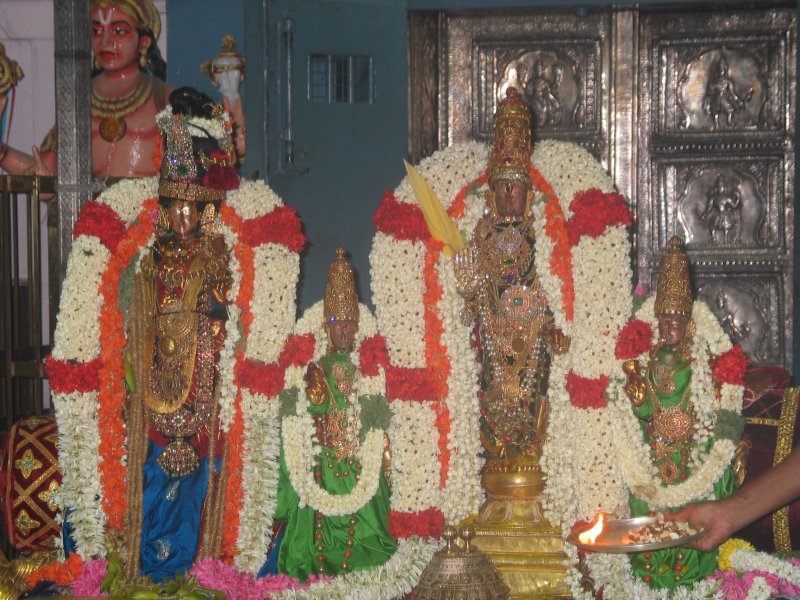GITA 11.8
We will see sloka 7 of Chapter 11:
ihaika-stham jagat krtsnam
pasyadya sa-caracaram
mama dehe gudakesha
yac canyad drastum icchasi
pasyadya sa-caracaram
mama dehe gudakesha
yac canyad drastum icchasi
"O Arjuna, whatever you wish to see, behold at once in this body of Mine! This universal form can show you whatever you now desire to see and whatever you may want to see in the future. Everything—moving and nonmoving—is here completely, in one place."
Today's [7th October 2008] lecture is from the Abhisheka mandapam. It is an important place. It is the place from where the Lord starts His procession. All Abhishekams are performed in this place only. On Tiruvadipooram [திரு ஆடிப் பூரம்], Kalyanotsavam is performed here only.
SRI ANDAL KALYANOTSAVAM
During that time Perialwar also graces, as the father of Sri Andal. He gave Sri Andal in marriage with Sri Ranganatha [though Perialwar might not be gracing the Kalyanotsavam of Sri Andal and Sri Ranganatha in Srirangam], and so here in Kanchi, he is also present in the Kalyanotsavam. The Lord appears majestically as the Bridegroom! This is one of His images. Thirumanjanam is performed every Hastham [ஹஸ்தம்] star day. Procession is on Ekadasi, Hastham, Amavasya, Masapirappu[மாதப்பிறப்பு], Sravanam, etc. For Abhishekam or procession, the Lord descends from the hill [Hasthigiri]. If there are more than Two days between Two festivals, then the Lord would ascend the Hill. But, if the next festival was on the next or day after, then the Lord would remain in the Mirror room [கண்ணாடி அறை] in this mandapam, and so, would not climb up the hill. Abhishekam is called Tirumanjanam, which means holy bath for the Lord. Abhishekam also means Crown [கிரீடம்]. During Tirumanjanam, one can enjoy admiring every organ of the Lord.
LORD SRI VARADAN IN TIRUMANJANAM
Both Swami Koorathalwan and Swami Vedanta Desika have appreciated the Lord in minute details. The tall Crown proclaims that He is the unquestionable Monarch of the Universe. Just below is the mark on His forehead [திலகம்]. It is oorthvapundram and appears to lift people below, says Swami Koorathalwan. In the ears the earrings are dazzling. It is not known whether they are ornaments for the ears or for the shoulders or for the hairstyle! We see the neck of the Lord and see three lines of impression. What are they? Swami Desika says that if we go and look at the Lord early morning, these lines would be clearly visible. The Lord was with Sri Perundevi Thayar previous night.The Divine Couple would have been lying embracing each other. The bangles of Sri Thayar would have been pressing the neck of the Lord and these marks are visible in the morning! That also shows that the Lord abides by the demands of Sri Thayar! Shoulders exhibit the discus and conch. Hasthigiri is Atthigiri [அத்திகிரி] in Tamil. Thigiri [திகிரி] means discus in Tamil. So Atthigiri means the elephant hill or it could also mean to point 'that discus!', in Tamil. On the right chest [வக்ஷஸ்தலம்], Sri Thayar is permanently residing. One can see a variety of necklaces of various precious stones and of a variety of colors. The sparkling of the precious stones resembles the splash of the smile, from His pearl-like teeth, descending like a stream and falling on the rock like broad chest!! We see His narrowed stomach and see the rope tied around. Swami Koorathalwan wonders why is the Lord displaying that rope by which He was tied [by Yasoda] so long back? Is it His first ornament! His lotus-like navel is like the whirlpool in rivers. Finally, we can see the Lotus-like feet pressed firmly on the Peetam. That is the place we have to surrender. Like He tells Arjuna, we can see whatever we want to in His Divine image.
(continued)


No comments:
Post a Comment